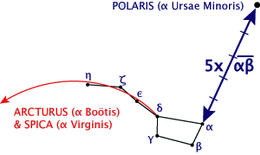| Revision as of 12:17, 21 March 2010 editSpecB (talk | contribs)170 editsm Undid revision 350919428 by 76.24.237.183 (talk) Now why would that be better than the previous link?← Previous edit | Revision as of 14:51, 24 March 2010 edit undoFionnghlas (talk | contribs)4 editsm →EuropeNext edit → | ||
| Line 9: | Line 9: | ||
| ].]] | ].]] | ||
| In |
In both ] and ], this pattern is known as the '''Plough'''. It is also occasionally referred to as the '''Butcher's Cleaver''' in northern ]. In ] the figure is sometimes called the ''']''' and has been used as a political symbol. | ||
| Known as '''Charles his waine''' in some areas of England, it was formerly called by the old ] '''Charles' Wain'''<ref name="Allen98">, by Richard Hinckley Allen</ref> ("wain" meaning "wagon," and derived from the still older ''Carlswæn''), as it still is in ], '''Karlavagnen''', '''Karlsvogna''', or '''Karlsvognen'''. A ] holds that it was named after ], but this common ] name meant the ''men's wagon'' (''the churls' wagon''), in contrast to the ''women's wagon'' (the ])<ref> by Gösta Bågenholm: ''"Som pendang till Karlavagnen kallas Lilla björn (latin Ursæ Minoris) för kvinnovagnen..."'' — as an appendix to the Mens Wagon the Little bear is called the Womens wagon</ref><ref>, by Elof Hellquist, entry ''Karlavagnen'': "I stället sammansatt" ... – "Instead composed from the appellative karl in opposition to Icelandic ''kvennavagn'' "</ref>. An older ''Odin's Wain'' may have preceeded these ] designations<ref name="Allen98"/>. Similarly, in ] and most ] it is known as "the Great Wagon", as opposed to "the Small Wagon," the ]. In ] it is called '''Großer Wagen''' (Great Cart). | Known as '''Charles his waine''' in some areas of England, it was formerly called by the old ] '''Charles' Wain'''<ref name="Allen98">, by Richard Hinckley Allen</ref> ("wain" meaning "wagon," and derived from the still older ''Carlswæn''), as it still is in ], '''Karlavagnen''', '''Karlsvogna''', or '''Karlsvognen'''. A ] holds that it was named after ], but this common ] name meant the ''men's wagon'' (''the churls' wagon''), in contrast to the ''women's wagon'' (the ])<ref> by Gösta Bågenholm: ''"Som pendang till Karlavagnen kallas Lilla björn (latin Ursæ Minoris) för kvinnovagnen..."'' — as an appendix to the Mens Wagon the Little bear is called the Womens wagon</ref><ref>, by Elof Hellquist, entry ''Karlavagnen'': "I stället sammansatt" ... – "Instead composed from the appellative karl in opposition to Icelandic ''kvennavagn'' "</ref>. An older ''Odin's Wain'' may have preceeded these ] designations<ref name="Allen98"/>. Similarly, in ] and most ] it is known as "the Great Wagon", as opposed to "the Small Wagon," the ]. In ] it is called '''Großer Wagen''' (Great Cart). | ||
Revision as of 14:51, 24 March 2010
This article is about the asterism. For other uses, see Big Dipper (disambiguation).| This article needs additional citations for verification. Please help improve this article by adding citations to reliable sources. Unsourced material may be challenged and removed. Find sources: "Big Dipper" – news · newspapers · books · scholar · JSTOR (February 2010) (Learn how and when to remove this message) |

The Plough or the Big Dipper is an asterism of seven stars that has been recognized as a distinct grouping in many cultures from time immemorial. The comprising stars are the seven brightest of the formal constellation Ursa Major.
Names and lore
Europe

In both Ireland and Britain, this pattern is known as the Plough. It is also occasionally referred to as the Butcher's Cleaver in northern England. In Ireland the figure is sometimes called the Starry Plough and has been used as a political symbol. Known as Charles his waine in some areas of England, it was formerly called by the old name Charles' Wain ("wain" meaning "wagon," and derived from the still older Carlswæn), as it still is in Scandinavia, Karlavagnen, Karlsvogna, or Karlsvognen. A folk etymology holds that it was named after Charlemagne, but this common Germanic name meant the men's wagon (the churls' wagon), in contrast to the women's wagon (the Little Dipper). An older Odin's Wain may have preceeded these Nordic designations. Similarly, in Romanian and most Slavic languages it is known as "the Great Wagon", as opposed to "the Small Wagon," the Little Dipper. In German it is called Großer Wagen (Great Cart).
In Dutch, its name is Steelpannetje (saucepan), due to its resemblance to the utensil.
In Finland the figure is known as Otava and widely used as a cultural symbol. In Finnish dialects, the word otava means a 'salmon net', but this word is largely obsolete in modern Finnish.
In Hungary, it is commonly called Göncölszekér ("Göncöl's cart") after a figure in Hungarian mythology, a táltos who carried medicines in his cart that could cure any disease.
These seven stars (septentriones, from the phrase septem triones, meaning "seven plough oxen") are the origin of the Latin word septentriones meaning "north" and now found as the adjective septentrional (northern) in English, French, Italian, Portuguese and Spanish.
Asia

In Hindu astronomy, it is referred to as (Vrihat) Sapta Rishi meaning "The Seven (Great) Sages".
Throughout eastern Asia, these stars compose the Northern Dipper. They are colloquially named "The Seven Stars of the Northern Dipper":
The seven stars are very important in Taoist astrology.
(Sometimes there are said to be nine stars — besides the seven visible stars, two invisible "attendant" stars, one on either side of the star Alkaid. These probably refer to two nearby Messier objects.)
Buruj Biduk (The Ladle) is the formation's name in Malaysia.
In Mongolia, it is known as the Seven Gods (Долоон бурхан)
An Arabian story has the four stars of the dipper's bowl as a coffin, with the three stars in the handle as mourners, following it.
North America

In North America it is known as the Big Dipper because the major stars can be seen to follow the rough outline of a large ladle or dipper. This figuration appears to be derived originally from Africa, where it was sometimes seen as a drinking gourd. In the 19th century, runaway slaves would "follow the Drinking Gourd" to the north and freedom.
A widespread American Indian figuration had the bowl as a bear. Some groups considered the handle to be three cubs following their mother, while others pictured three hunters tracking the bear. (For example, see Abenaki mythology.) The Dipper appears on some Tribal flags, while the flag of the state of Alaska features a stylized Big Dipper and North Star.
Other
The Bible refers to it as "the seven stars" (Amos 5:8).
Book XVIII of Homer's Iliad mentions it as "the Bear, which men also call the Wain."
In Tolkien's Middle-earth mythos, it is called the Valacirca (Sickle of the Valar), the sign of Hope signifying doom for Evil, while in T.A. Barron's Great Tree of Avalon series, it is called the Wizard's Staff, symbolizing Merlin's staff.
It is a prominent symbol in the Fist of the North Star manga/anime series.
In addition to appearing on the flags of political entities, the Dipper has also been used in corporate logos.
Stars
Within Ursa Major the stars of the Big Dipper have Bayer designations in consecutive Greek alphabetical order from the bowl to the handle.

Mizar and Alcor are at the upper right.
| Proper Name |
Bayer Designation |
Apparent Magnitude |
Distance (L Yrs) |
|---|---|---|---|
| Dubhe | α UMa | 1.8 | 124 |
| Merak | β UMa | 2.4 | 79 |
| Phecda | γ UMa | 2.4 | 84 |
| Megrez | δ UMa | 3.3 | 81 |
| Alioth | ε UMa | 1.8 | 81 |
| Mizar | ζ UMa | 2.1 | 78 |
| Alkaid | η UMa | 1.9 | 101 |
In the same line of sight as Mizar, but three light-years beyond it, is the star Alcor (80 UMa). Together they are known as the Horse and Rider. At fourth magnitude, Alcor would normally be relatively easy to see with the unaided eye, but its proximity to Mizar renders it more difficult to resolve, and it has served as a traditional test of sight. Mizar itself has four components and thus enjoys the distinction of being part of an optical binary as well as being the first-discovered telescopic binary (1617) and the first-discovered spectroscopic binary (1889).
Five of the stars of the Big Dipper are at the core of the Ursa Major Moving Group. The two at the ends, Dubhe and Alkaid, are not part of the swarm, and are moving in the opposite direction. Relative to the central five, they are moving down and to the right in the map. This will slowly change the Dipper's shape, with the bowl opening up and the handle becoming more bent. In 50,000 years the Dipper will no longer exist as we know it, but be re-formed into a new Dipper facing the opposite way. The stars Alkaid to Phecda will then constitute the bowl, while Phecda, Merak, and Dubhe will be the handle.
Guidepost

Not only are the stars in the Big Dipper easily found themselves, they may also be used as guides to yet other stars. Thus it is often the starting point for introducing Northern Hemisphere beginners to the night sky:
- Polaris, the North Star, is found by imagining a line from Merak (β) to Dubhe (α) and then extending it for five times the distance between the two Pointers.
- Extending a line from Megrez (δ) to Phecda (γ), on the inside of the bowl, leads to Regulus (α Leonis) and Alphard (α Hydrae). A mnemonic for this is "A hole in the bowl will leak on Leo."
- Crossing the top of the bowl from Megrez (δ) to Dubhe (α) takes one in the direction of Capella (α Aurigae). A mnemonic for this is "Cap to Capella."
- Castor and Pollux (α and β Geminorum) can be located by crossing the bottom of the bowl from Phecda (γ) to Merak (β) and continuing onward.
- By following the curve of the handle from Alioth (ε) to Mizar (ζ) to Alkaid (η), one reaches Arcturus (α Boötis) and Spica (α Virginis). A mnemonic for this is "Arc to Arcturus then speed to Spica."
Additionally, the Dipper may be used as a guide to telescopic objects:
- The approximate location of the Hubble Deep Field can be found by following a line from Phecda (γ) to Megrez (δ) and continuing on for the same distance again.
- Crossing the bowl diagonally from Phecda (γ) to Dubhe (α) and proceeding onward for a similar stretch leads to the bright galaxy pair M81 and M82.
- Two spectacular spiral galaxies flank Alkaid (η), the Pinwheel (M101). to the north, and the Whirlpool (M51), to the south.
See also
- Ursa Major, the constellation of which the Big Dipper is part
- Little Dipper
- Tell time using the Big Dipper
Notes
- ^ Star Names: Their Lore and Meaning – "Ursa Major", by Richard Hinckley Allen
- "150 ord och begrepp inom astronomisk navigation" by Gösta Bågenholm: "Som pendang till Karlavagnen kallas Lilla björn (latin Ursæ Minoris) för kvinnovagnen..." — as an appendix to the Mens Wagon the Little bear is called the Womens wagon
- Svensk etymologisk ordbok (1922), by Elof Hellquist, entry Karlavagnen: "I stället sammansatt" ... – "Instead composed from the appellative karl in opposition to Icelandic kvennavagn "
- In order not to be confused with the Little Dipper, our asterism is also called Nagy Göncöl or "Big Göncöl".
- Merriam-Webster
- As per the Hebrew and the King James Version. Other translations have "the Pleiades," which also has seven stars visible to the naked eye.]
- Iliad
- Allen P. Adamson (2007). Brandsimple: how the best brands keep it simple and succeed. Palgrave Macmillan. p. 101. ISBN 9781403984906.
{{cite book}}: Unknown parameter|coauthors=ignored (|author=suggested) (help) For an example see Iridium Satellite LLC.